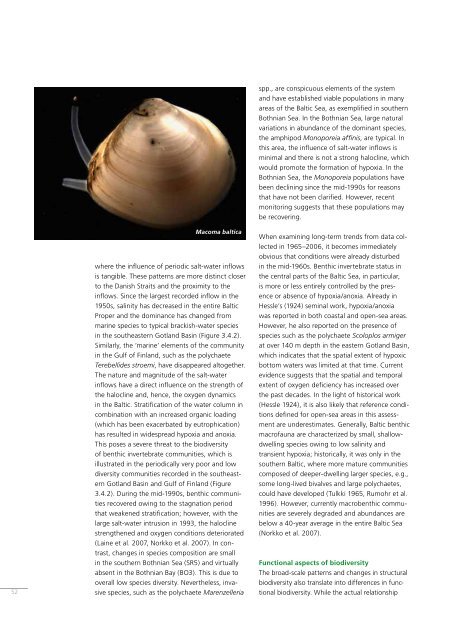BSEP116B Biodiversity in the Baltic Sea - Helcom
BSEP116B Biodiversity in the Baltic Sea - Helcom
BSEP116B Biodiversity in the Baltic Sea - Helcom
You also want an ePaper? Increase the reach of your titles
YUMPU automatically turns print PDFs into web optimized ePapers that Google loves.
52<br />
Macoma baltica<br />
where <strong>the</strong> <strong>in</strong>fluence of periodic salt-water <strong>in</strong>flows<br />
is tangible. These patterns are more dist<strong>in</strong>ct closer<br />
to <strong>the</strong> Danish Straits and <strong>the</strong> proximity to <strong>the</strong><br />
<strong>in</strong>flows. S<strong>in</strong>ce <strong>the</strong> largest recorded <strong>in</strong>flow <strong>in</strong> <strong>the</strong><br />
1950s, sal<strong>in</strong>ity has decreased <strong>in</strong> <strong>the</strong> entire <strong>Baltic</strong><br />
Proper and <strong>the</strong> dom<strong>in</strong>ance has changed from<br />
mar<strong>in</strong>e species to typical brackish-water species<br />
<strong>in</strong> <strong>the</strong> sou<strong>the</strong>astern Gotland Bas<strong>in</strong> (Figure 3.4.2).<br />
Similarly, <strong>the</strong> ‘mar<strong>in</strong>e’ elements of <strong>the</strong> community<br />
<strong>in</strong> <strong>the</strong> Gulf of F<strong>in</strong>land, such as <strong>the</strong> polychaete<br />
Terebellides stroemi, have disappeared altoge<strong>the</strong>r.<br />
The nature and magnitude of <strong>the</strong> salt-water<br />
<strong>in</strong>flows have a direct <strong>in</strong>fluence on <strong>the</strong> strength of<br />
<strong>the</strong> halocl<strong>in</strong>e and, hence, <strong>the</strong> oxygen dynamics<br />
<strong>in</strong> <strong>the</strong> <strong>Baltic</strong>. Stratification of <strong>the</strong> water column <strong>in</strong><br />
comb<strong>in</strong>ation with an <strong>in</strong>creased organic load<strong>in</strong>g<br />
(which has been exacerbated by eutrophication)<br />
has resulted <strong>in</strong> widespread hypoxia and anoxia.<br />
This poses a severe threat to <strong>the</strong> biodiversity<br />
of benthic <strong>in</strong>vertebrate communities, which is<br />
illustrated <strong>in</strong> <strong>the</strong> periodically very poor and low<br />
diversity communities recorded <strong>in</strong> <strong>the</strong> sou<strong>the</strong>astern<br />
Gotland Bas<strong>in</strong> and Gulf of F<strong>in</strong>land (Figure<br />
3.4.2). Dur<strong>in</strong>g <strong>the</strong> mid-1990s, benthic communities<br />
recovered ow<strong>in</strong>g to <strong>the</strong> stagnation period<br />
that weakened stratification; however, with <strong>the</strong><br />
large salt-water <strong>in</strong>trusion <strong>in</strong> 1993, <strong>the</strong> halocl<strong>in</strong>e<br />
streng<strong>the</strong>ned and oxygen conditions deteriorated<br />
(La<strong>in</strong>e et al. 2007, Norkko et al. 2007). In contrast,<br />
changes <strong>in</strong> species composition are small<br />
<strong>in</strong> <strong>the</strong> sou<strong>the</strong>rn Bothnian <strong>Sea</strong> (SR5) and virtually<br />
absent <strong>in</strong> <strong>the</strong> Bothnian Bay (BO3). This is due to<br />
overall low species diversity. Never<strong>the</strong>less, <strong>in</strong>vasive<br />
species, such as <strong>the</strong> polychaete Marenzelleria<br />
spp., are conspicuous elements of <strong>the</strong> system<br />
and have established viable populations <strong>in</strong> many<br />
areas of <strong>the</strong> <strong>Baltic</strong> <strong>Sea</strong>, as exemplified <strong>in</strong> sou<strong>the</strong>rn<br />
Bothnian <strong>Sea</strong>. In <strong>the</strong> Bothnian <strong>Sea</strong>, large natural<br />
variations <strong>in</strong> abundance of <strong>the</strong> dom<strong>in</strong>ant species,<br />
<strong>the</strong> amphipod Monoporeia aff<strong>in</strong>is, are typical. In<br />
this area, <strong>the</strong> <strong>in</strong>fluence of salt-water <strong>in</strong>flows is<br />
m<strong>in</strong>imal and <strong>the</strong>re is not a strong halocl<strong>in</strong>e, which<br />
would promote <strong>the</strong> formation of hypoxia. In <strong>the</strong><br />
Bothnian <strong>Sea</strong>, <strong>the</strong> Monoporeia populations have<br />
been decl<strong>in</strong><strong>in</strong>g s<strong>in</strong>ce <strong>the</strong> mid-1990s for reasons<br />
that have not been clarified. However, recent<br />
monitor<strong>in</strong>g suggests that <strong>the</strong>se populations may<br />
be recover<strong>in</strong>g.<br />
When exam<strong>in</strong><strong>in</strong>g long-term trends from data collected<br />
<strong>in</strong> 1965–2006, it becomes immediately<br />
obvious that conditions were already disturbed<br />
<strong>in</strong> <strong>the</strong> mid-1960s. Benthic <strong>in</strong>vertebrate status <strong>in</strong><br />
<strong>the</strong> central parts of <strong>the</strong> <strong>Baltic</strong> <strong>Sea</strong>, <strong>in</strong> particular,<br />
is more or less entirely controlled by <strong>the</strong> presence<br />
or absence of hypoxia/anoxia. Already <strong>in</strong><br />
Hessle’s (1924) sem<strong>in</strong>al work, hypoxia/anoxia<br />
was reported <strong>in</strong> both coastal and open-sea areas.<br />
However, he also reported on <strong>the</strong> presence of<br />
species such as <strong>the</strong> polychaete Scoloplos armiger<br />
at over 140 m depth <strong>in</strong> <strong>the</strong> eastern Gotland Bas<strong>in</strong>,<br />
which <strong>in</strong>dicates that <strong>the</strong> spatial extent of hypoxic<br />
bottom waters was limited at that time. Current<br />
evidence suggests that <strong>the</strong> spatial and temporal<br />
extent of oxygen deficiency has <strong>in</strong>creased over<br />
<strong>the</strong> past decades. In <strong>the</strong> light of historical work<br />
(Hessle 1924), it is also likely that reference conditions<br />
def<strong>in</strong>ed for open-sea areas <strong>in</strong> this assessment<br />
are underestimates. Generally, <strong>Baltic</strong> benthic<br />
macrofauna are characterized by small, shallowdwell<strong>in</strong>g<br />
species ow<strong>in</strong>g to low sal<strong>in</strong>ity and<br />
transient hypoxia; historically, it was only <strong>in</strong> <strong>the</strong><br />
sou<strong>the</strong>rn <strong>Baltic</strong>, where more mature communities<br />
composed of deeper-dwell<strong>in</strong>g larger species, e.g.,<br />
some long-lived bivalves and large polychaetes,<br />
could have developed (Tulkki 1965, Rumohr et al.<br />
1996). However, currently macrobenthic communities<br />
are severely degraded and abundances are<br />
below a 40-year average <strong>in</strong> <strong>the</strong> entire <strong>Baltic</strong> <strong>Sea</strong><br />
(Norkko et al. 2007).<br />
Functional aspects of biodiversity<br />
The broad-scale patterns and changes <strong>in</strong> structural<br />
biodiversity also translate <strong>in</strong>to differences <strong>in</strong> functional<br />
biodiversity. While <strong>the</strong> actual relationship

















